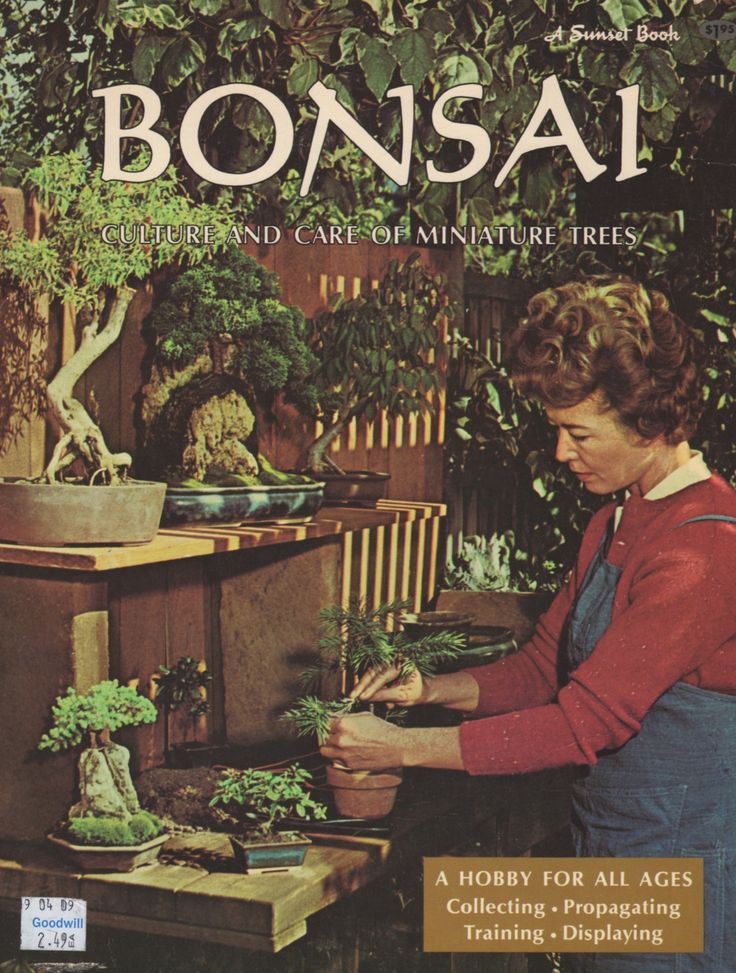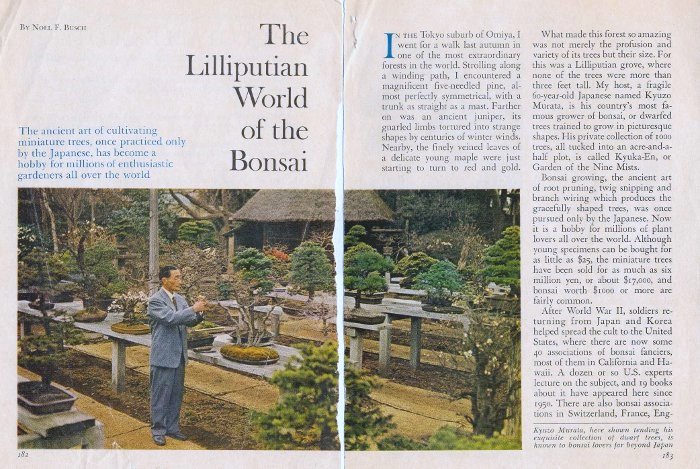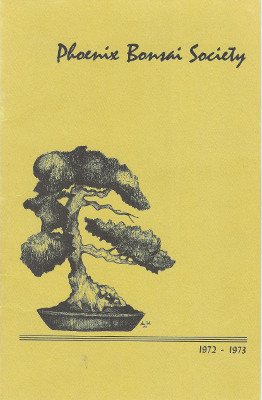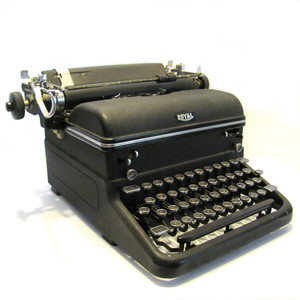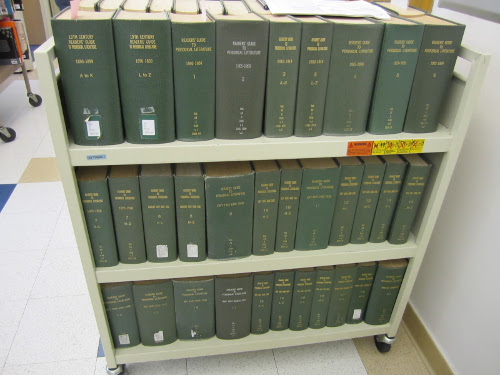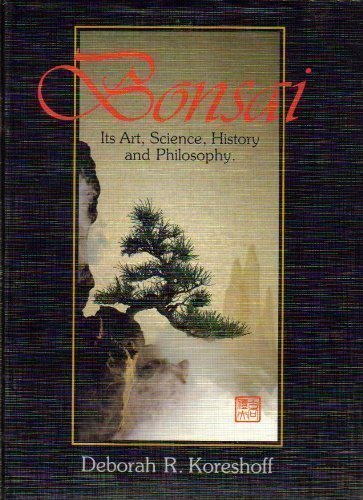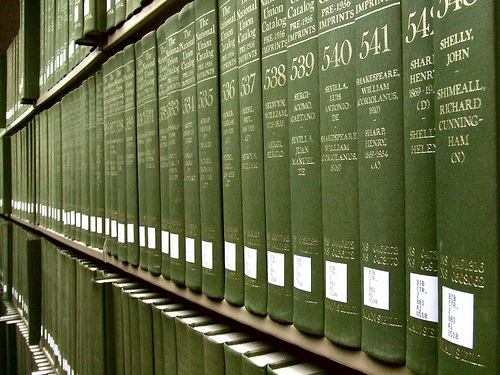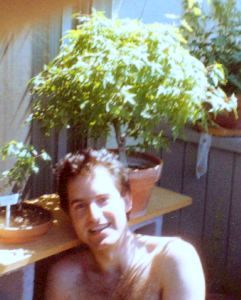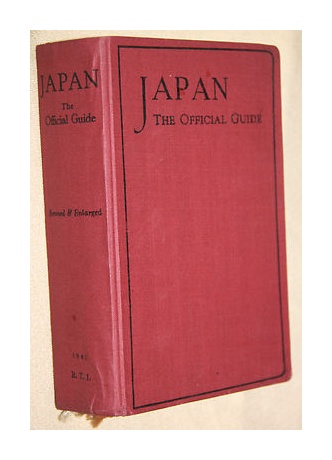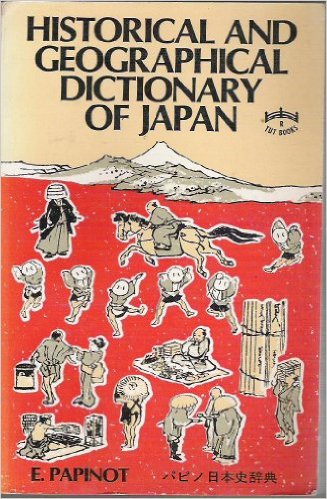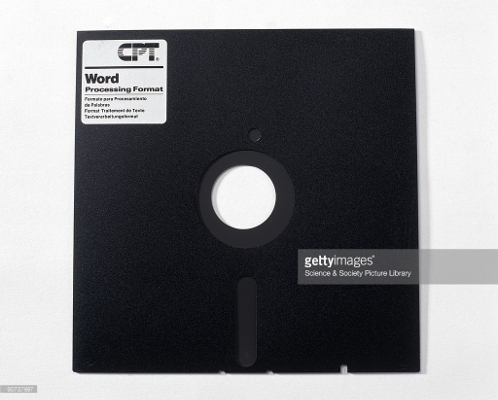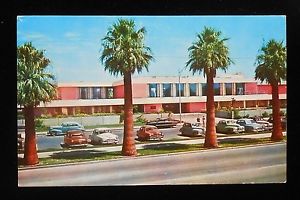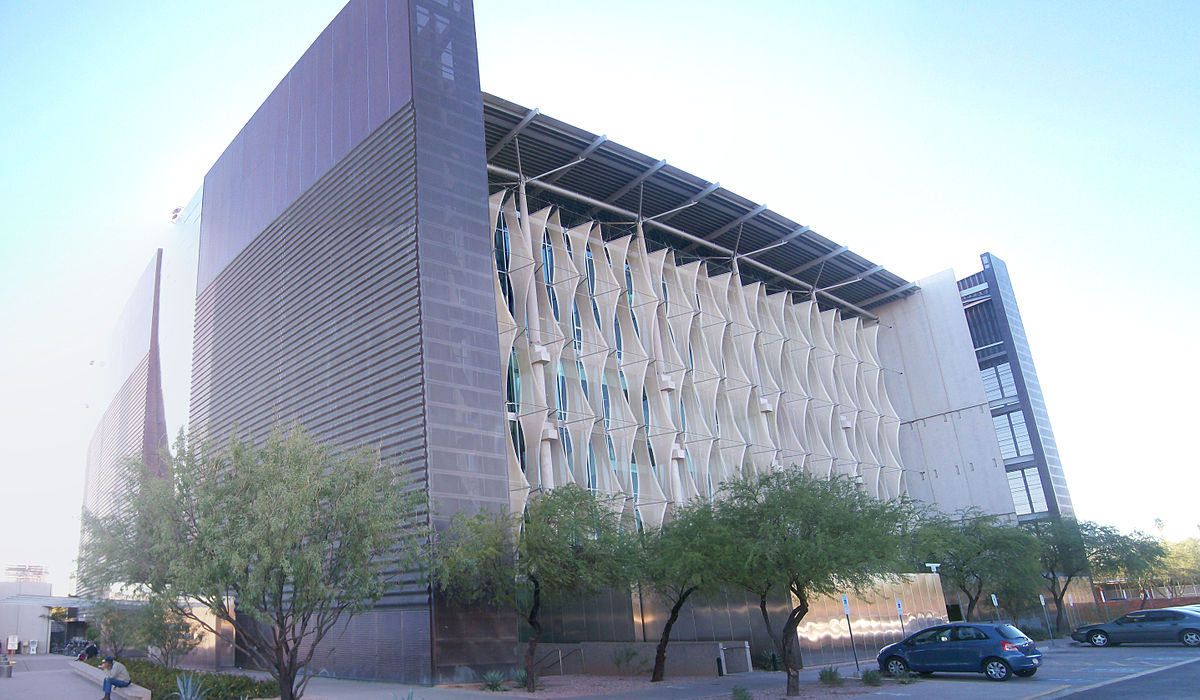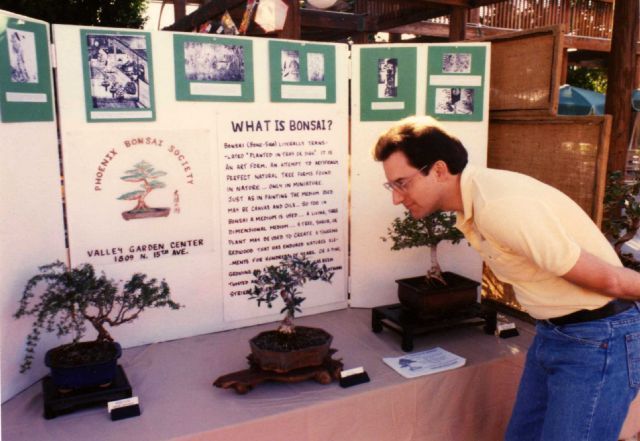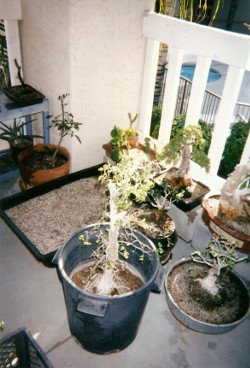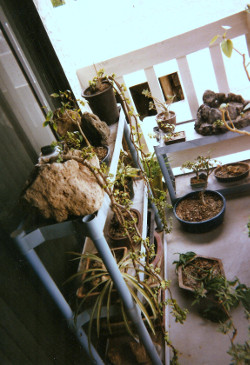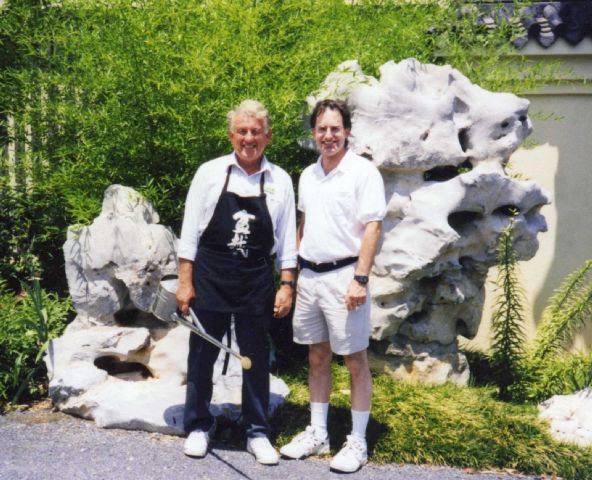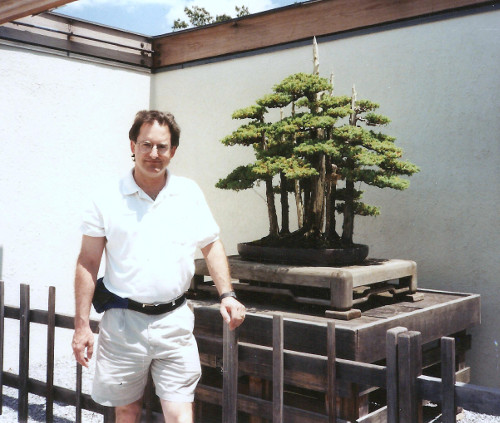|
Thank-you for considering to read this material.
In additional to the following somewhat free-form and partly chronological presentation, please also see RJB bio page, Magical Miniature Landscapes intro, and SiteKudos page for additional background. This project has been and continues to be a group effort. Born in 1955, I first learned about bonsai through Ann Pipe's book in late October 1969. I had stopped off at the local branch library (the Parma-Snow Branch of Cuyahoga County Public Library) after school and wanted to get something to read. I wandered looking up and down the stacks for a few minutes and then stopped in front of a very small group of bonsai books. Ann's book caught my attention and I checked it out. As this was in the days before seemingly every house had a copier/printer -- yes, pre-PC -- I used tracing paper to record several of the line drawings therein. (The volume was returned on time -- though I may have renewed it once -- and those delicate sketches have long since disappeared. That particular book's value these days is only one of historical interest, at best...)
Over the next 16 years, other than the 1967 Readers' Digest article about Murata (read a few years after publication), the first Sunset Bonsai book, and few occasional newspaper articles, I really didn't read anything about bonsai or its background. Four months after we moved from Cleveland, Ohio to Phoenix, Arizona in mid-1971, my uncle, Greg Vargo, happened to take me sightseeing at the end of October. We ended up at the Desert Botanical Garden -- which just happened to be having the final day of a show by the Phoenix Bonsai Society. When he saw my astonished viewing of the dwarfed trees there, my uncle signed me up for a nominal membership. However, as I didn't have my driver's license yet and my family lived on the other side of the Valley, I never made it to any club meetings. But, I did receive a copy of the next yearbook from the club, and I added that to my slim bonsai library. (I found out later that John Naka had conducted a workshop the first day of that weekend show. It would be years before I met that sensei, but I do still have that yearbook.)
I received one of those small juniper bonsai and round tan pot kits for Christmas of 1971. I don't remember how long that little plant stayed around. A plant or two a year -- mostly junipers -- were kept by me during the next decade or so as minimal experience, usually in an orange clay flowerpot after receiving a little pruning to shape roughly. A medium-sized nursery juniper I purchased in November 1974 while in college in Tucson and cared for there was taken from outside my second-floor Phoenix apartment front door two years later. [The supreme irony, if truth be told, is that I actually had dropped my college botany class during the last month I was taking it because the "D" I was getting would have brought down my GPA too much. College for me was a time more of social growth than academic... I had been an "A" student in Honors English in high school. Our final assignment in that course was actually creating a bibliography of various areas of the school's library. My particular subject was the group of fantasy and science fiction works. My mom had told me that I didn't like to read up until third grade. Before that time I supposedly picked out library books that had the most pictures and fewest words. I seemed to have made up for that since then with a vengence. By sixth grade I was starting to write a science fiction novel, though I only completed a few chapters. Short stories in that genre were produced in late high school and college. I do have a nice collection of rejection slips from the big names in the industry during the mid-seventies. And twice I did try to co-write two different sci-fi novels -- one being with a long distance partnership. Neither of those stories grew very far...] Along the lines of other subjects, I did happen to have been familiarizing myself a little, however, with Chinese history since the late 1970s due to some ongoing research on the Chinese pyramids, specifically those near the city of Xian. Also, I've compiled my own interpretations of the 81 chapters of the Dao De Jing, and I had a little formal training in judo, and some informal training in kung fu and tai chi chuan. Freshman year of high school had included a typing class -- arguably the most influential course I ever took in high school or college. After that, my folks got me (literally) a big old Royal manual typewriter which some other school was selling when they upgraded what they used. (Senior year I was on the yearbook staff.) The typewriter was used by me throughout high school and into college, where I made a little extra money typing class assignments for my fraternity brothers. A second similar machine replaced that one eventually. Any number of projects I was working on over the years were composed and recomposed with that device. In the mid-1970s during my two year stint as a security guard, mostly at the steam power plant in south Phoenix, I developed small hand-printed note-taking which continues to this day. Over the past several decades, though, my full-sized handwriting -- both printed and cursive --seems to have gotten objectively worse from increasing speed...
In college I had taken a course in Fortran with punch cards. Four years later a buddy and I bought one of the first Radio Shack TRS-80 computers sold in Phoenix. Its storage was a casette tape player. The following year through 1980 I worked at a mirror/flat glass warehouse where I first met up with a computerized inventory system using a large light blue IBM 360 unit. I discovered my talent for standardizing descriptions and abbreviations -- something which would serve me even through today. More creatively, perhaps, at this time I wrote a few articles for Tempe's Gentle Strength Co-op Newsletter. A small Christmas-type pine tree which I had for a few months during the winter of 1982-83 was carried away by a neighborhood dog; a Crassula jade tree from August 1984 and a 1-gallon juniper from that September were individually stolen from my doorstep in the spring of 1985. I initially got serious about bonsai in February 1986 when I planted some seeds gotten through a Spencer Gifts mail order bonsai kit containing eight varieties. Twenty-three plants did grow, representing all eight species, but only through the middle of summer. A lone and delicate beautiful little Japanese Red Pine (Pinus densiflora) lasted the longest -- through late July 1987 when I accidentally left it on the south-facing apartment porch rail till late morning [in Phoenix, AZ]. Other and larger nursery, dug, or established trees would come and go through my collection. (And reviewing my notes, I see that I also had a 3-gallon-size Italian Stone Pine (P. pinea) Christmas tree from December 1985 to June 86; a Michigan Bulb Company mail-order Red maple which lasted from March 86 until the following winter; and many other plants -- including azaleas, Ming aralia (Polyscias fruticosa), Colorado blue spruce (Picea pungens), elms and junipers and pines -- which each only lasted a few months at most. Some passed on from overexposure to the sun.) The first books about bonsai which I read starting in early 1986 included: the Brooklyn Botanic Garden's Handbook of Bonsai: Special Techniques, Bonsai by Paul Lesniewicz, The Masters' Book of Bonsai by Koide Nobukichi et al, Miniatures and Bonsai by Philip Perl, The Beginner's Guide to American Bonsai by Jerald P. Stowell, A Dwarfed Tree Manual for Westerners by Samuel Newsom, Bonsai -- Miniature Trees by Claude Chidamian, The Creative Art of Bonsai by Isabelle and Rémy Samson, and Shufunotomo's The Essentials of Bonsai. Their few lines about the history were written down and constituted the beginning of my journey. |
|||||||||||||||||||
|
In the spring of 1986 I joined the American Bonsai Society and started
receiving their quarterly Bonsai Journal and the ABStracts newsletter.
At the old Main Phoenix Public Library (across the street from where I worked), I scoured the Reader's Guide to Periodical Literature to track down early articles and references. I basically chose articles from what was suggested by the title, and then looked them up. As the Library had a good selection of bound and microfilmed periodicals, I'd make a certain length list and then hit the shelves or the cabinets. I easily perused at least 5x as many articles as finally made the first versions of the pre-WWII and post-WWII lists (a handy though arbitrary division point) over the next few years. (I'm sure not all the articles published have yet been found.)
In September I joined the Phoenix Bonsai Society. (The club had relocated its meetings from the east-side Desert Botanical Garden to the near downtown Valley Garden Center in the Fall of 1973.) And this is when I finally was introduced to both use of a proper coarse soil mix with chicken grit/roofing pebbles instead of just garden or potting soil, and protection via shade cloth and well-timed shadow. More successfully, in a short time I would discover the club library's holdings of back issues of BCI's Bonsai Magazine and IBA's International Bonsai. Then I studied various members' private holdings of Bonsai Today and some early copies of the ABS Bonsai Journal (Vol. 1-5 hard bound in one volume) and current GSBF Golden Statements. Wu Yee-Sun's Man Lung Artistic Pot Plants, editions 1 and 2, were seen in the holdings of the PBS, as well as John Naka's Bonsai Techniques I, II, and Satsuki (this latter being an out-of-print volume which, unfortunately, later disappeared). I photocopied much -- four file cabinet drawers' worth to date. A copy of Deborah Koreshoff's 1984 Bonsai; Its Art, Science, History and Philosophy was found at Arizona State University's library in December 1986. Its nineteen page history would have sufficed this researcher if it had been read six months earlier -- but when I did view it I discovered that I had already uncovered a few bits of early American bonsai history not dealt with by Australian Koreshoff. Probably the first big "A-ha!" moment. So, I continued... (That same library visited yielded the first of the old Garden and Forest articles I would find.) At this time I was finishing up a semester of Conversational Japanese at a local community college. I aced that class -- taught by a female instructor who was a Japanese native -- but did not otherwise formally follow-up my studies along those lines. (I had previously taken three years of French in high school and two of German in college. In the early eighties my private studies included linguistics. About 60 grammars, phrase books, and dictionaries remain from used book store purchases during those days.)
The bibliography early on was expanded to include other titles known-of but not seen. There was the Phoenix Public Library's copy of the National Union Catalog Pre-1956 Imprints (© 1970 Mansell Information/Publishing Limited. ©1970 The American Library Association, Chicago. With 685 main volumes and another sixty-nine (plus?) as supplements, this was very roughly the closest American equivalent you could readily find to the numerous massive encyclopedias of old China). It was searched for titles, principally by known and intuited -- Japanese mostly -- authors' last names. This was done, fortunately, at the library's old site on McDowell Rd. (After the move a few blocks south on Central Ave., these volumes were stored out of ready access.) The Phoenix Art Museum, right next door to the old location, was visited on my lunch hour during a few Japanese woodblock print exhibitions.
From February 1987 through 2002, I participated in the Phoenix Bonsai Society's largest show of the year, which was a part of the City of Phoenix Japanese Week Matsuri. This included, of course, early Saturday morning set up with my fellow club members -- all the way through to Sunday afternoon tear down. Most years I did have a modest tree or two to display. A valuable piece of advice the club maintained was "your tree will never look any better than when it is in a show with other trees." We often did not think highly of our own compositions, but when we finally got up the nerve to display one of them placed next to similar ones, suddenly our humble productions actually looked rather nice. And if we happened to overhear members of the general public praising these -- wow, we actually succeeded in making one of these! At these shows I could discuss with club members and general public on a one-on-one basis some of the things I was learning about the history of bonsai in general, picking up a few things I didn't know, and making an occasional correction to the commonly-held bonsai mythology. At some point I did the voice-over for a few of the demonstrations presented during the shows, adding a few more historical details as the years went by. In early 1987 and 1988 I tried growing several types of pine and maples from seed. Some of the former came from cones gathered right before Encanto Park, a little bit to the north of the Valley Garden Center, was renovated. The seedlings were all gone by August of 1988. Maple and Chinese elm cuttings were attempted, but our cats insisted on "salad-barring" these no matter where we put the plastic-covered containers. By this time any apartment I would live in would be a second-floor one with a balcony for my trees to remain safe on. Ground floor living would only be O.K. in a house with a secure backyard.
Research-wise, background info via Japan the Official Guide (copy of 1941 edition gotten at the Visiting Nurses Auxilary Annual Booksale in February 1988) and E. Papinot's Historical and Geographical Dictionary of Japan continued to connect a few more dots.
August 1989 my researches moved the earliest known use of "bonsai" in English [at the time] back a generation. I have fond memories of getting up a little earlier before going to work in order to wake up my mental engines by having breakfast while reading a chapter from Dr. Philipp Franz von Siebold's Manners and Customs of the Japanese or Col. Sir Henry Yule's (trans. & ed.) The Book of Ser Marco Polo The Venetian Concerning the Kingdoms and Marvels of the East or Emil Bretschneider, M.D.'s History of European Botanical Discoveries in China and also his Botanicon Sinicum. CPT 8" Floppy disks were the first storage media for the history which I was starting to compile, afterhours where I worked . (I had taken a CPT Word Processing course there in late 1984.)
The earliest lecture I gave on the history of bonsai took place in September of 1989 at a meeting of the Phoenix club. For most of the members present, this was the first time they were aware that such a thing existed. (One more formal lecture in front of the club would follow, as well as a lecture for a local civic group and then a 45 minute run-through to a captive audience of 3 other club members during part of the 100 mile return trip from a Tucson nursery in June of 2000.) Also accompanying me to many of the Phoenix club meetings was my son, Andrew (b. 1990). On occasions he helped pick winning members' names for club raffles, as well as sometimes sitting in the corner of the meeting room making Lego® bonsai. (This was at least 15 years before an official Lego® bonsai set was released.) His mother, my first wife, would refer to my bonsai historical research (half-humorously?) as "the other woman." --------------------------------------------------
|
|||||||||||||||||||
|
GOING PUBLIC
One of the members of the Phoenix Bonsai Society (whose name is long forgotten) suggested to me during the February 1990 Matsuri show that the way to prelude a book was by having articles on the subject published first. So I wrote "Hachi No Ki" (my first hand-written draft is undated; my typed submission was responded to by ABS editor Jack Wikle on May 29, 1990). Several contemporary references had made passing mention of this Noh play -- including variations on the lead character's name -- and I thought the story deserved further telling of background and plot. This was followed by "Some Bonsai Futures" (first hand-written draft is dated July 1, 1990; typed submission responded to on October 25, 1990). But Jack Wikle wisely suggested "Futures" would be a stronger/better introduction of me to the bonsai community. The many history notes I'd compiled had gotten me thinking about what we probably would see and experience regarding this art/hobby. The article did require substantial rewriting on my part based on many perceptive observations by Jack. After two last-minute publication drops due to space considerations, "Some Bonsai Futures" was finally published in the Fall 1991 issue of ABS Journal. "Hachi No Ki" was then published in the Summer 1992 issue, having been passed on to the new editor, Arch Hawkins.
[The first corporate history I ever worked on was for the private family-owned company I was employed at from January 1984 to August 1992. The history was, perhaps, semi-official but I am not aware my researches were ever published or used in any official format. I had been given access to some private documents. This is where I first began incorporating the stories of vendors and a few social events into the tale of the main subject to better flesh out the full picture. No organization developed in a vacuum. It was also at that company where I gained some elementary experience in writing programs for a number of inventory reports using Unix.] I retyped my book notes into a Commodore 64 word processing program (Home-Office Writer) and expanded the draft (1990-93). (I still have some printed pages of notes liberally covered with hand-printed additions from the latest books I was reading at the time.)
"America Peeks" was published in the Winter 1992 Journal, having initially been received by Arch Hawkins by mid-October 1992. (My hand-written first draft for the article "18th & 19th Century America's Peaks [sic] at Bonsai" is dated August 28, 1992; the second draft with the final title is from September 3). The Colonial involvement with the China trade pushed back our first exposures to dwarf potted trees and I wanted to share this knowledge. Then, as at my new job place I learned my way around WordPerfect software, I retyped all the growing book notes again (1993-98), but later was able to have them switched fairly automatically over to MS Word (c.1998) when that was my work-related software program. (By that time my home computer would have been switched over to a series of IBM-compatible machines.) My understanding of this project I was now doing was to compile the kind of history I wished had existed when I'd gotten serious about bonsai. Annual workshops with visiting teachers were started for the Phoenix club in August 1993. Our first guest sensei was Mel Ikeda, followed by Jim Barrett (who I specifically interviewed for historical info), Sze-Ern "Ernie" Kuo, Roy Nagatoshi, and Ben Oki. Ben was our annual teacher from 1998 up to 2012, with his workshops early on moved to a slightly cooler October and then November setting. David Nguy took over the workshops beginning in 2013, but I have not actually met him, having not gotten back to Phoenix during his visits. One particular tree I had resulted in an early monograph. Because of the long, hot summers in Phoenix where everything seemed to stop growing mid-year, I turned some of my attention to a large Elephant Food (Portulacaria afra) I had been gifted. Able to grow happily in the heat, with cuttings very, very easily rooting, this and its progeny provided me with a lot of research material beginning with my first extensive notes in 1993. I worked with a number of P. afra varieties over the years. (I am reminded that a few years earlier when I started keeping notes on my attempts at bonsai I had put together a fairly extensive care sheet on bougainvillea. My even more extensive P. afra notes would be the next logical outgrowth.) Many set decorations involving bonsai or reasonable facsimiles were discovered while just relaxing and watching TV or movies/videos. They were chronologically-listed in my book notes. My very first hand-written draft of an article was dated November 18, 1992 and titled "On the Big and Small Screen." It did have a subsection with just the "Star Trek" episodes labeled with the word-play "To Boldly Grow." But nothing much was done with this for nearly three years. The first dated typed version is marked August 1, 1995 with the title "Some Screen Portrayals of Bonsai." My hand-written editing of this changed the title to "To Boldly Grow: Some Cinematic Bonsai." Per an e-mail to RJB from editor Jill Hurd on November 8, 1995, the article was split into two parts and put into a two-column format (which I also used when the info was reproduced on this website). The article saw print in ABS Bonsai Journal issues Winter 1995 and Spring 1996. I hadn't seen anything like this in the magazines previously, so I thought maybe it would be fun to do. Some of the references I had gathered were not used in that particular article. Many of the other references were found in posts on the Internet Bonsai Club's newsgroup (eventually either with or without some passing mention to this site's listings), and a few notes were just e-mailed directly to me. These became "To Boldly Grow: Some Celluloid Bonsai (Part III)." (At least one acquaintance has reprimanded me about using the split infinitive...) Hud Nordin's opening haiku originated in an e-mail to me about the year 2000. In 2001 I split the references after the year 1999 into a Part IV. As additional sightings were made or brought to my attention they were put into the appropriate part (III or IV) of the chronology. A summary and analysis of the years and media was first compiled in November 2004. I finally got around to begin including computer and video games portrayals near the end of April 2005. (My kids occasionally mention that they have found other bonsai in the games, but if I don't get details from them, no additions to the website's listing.)
Some of the trees attempted for bonsai during this period included mostly nursery-sourced Sweet acacias (Acacia farnesiana), Japanese and Trident maples (Acer palmatum and A. buergerianum), Bougainvilleas, Japanese boxwoods (Buxus microphylla), Western hackberry (Celtis reticulata), Desert willow (Chilopsis linearis), Texas olive (Cordia boisseri), Sago palm (Cycas revoluta), Weeping figs (Ficus benjamina), Arizona ash (Fraxinus velutina), Ginkgo (Ginkgo biloba), Yaupon hollies (Ilex vomitoria), assorted Junipers, Japanese privet (Ligustrum japonicum), American sweetgums (Liquidamber styraciflua), Crape myrtle (Lagerstroemia indica), Desert fern (Lysiloma thornberi), Pink melaleuca (Melaleuca nesophila), Common mulberry (Morus alba), Dwarf myrtles (Myrtus communis), Heavenly bamboos (Nandina domestica), assorted Pines, Texas ebony (Pithecellobium flexicaule), Pomegranates (Punica granatum), African sumac (Rhus lancea), assorted Chinese elms (Ulmus parviflora), and Monk's pepper (Vitex agnus-castus). These lasted a few months to several years, in pots and a few spent some time in a growing bed. I was able to display a few in our club meeting displays or large public shows. Mostly hand-written notes recorded these plants, although there were the beginnings of computer notes as well. One particular dig by invitation was at a residence on the side of Mummy Mountain where a water line under a raised garden running the length of a private driveway needed to be replaced in the summer of 1993. This resulted in the club collecting a few dozen 35-year-old bougainvilleas. I remember that a few weeks later at a club meeting, I was able to use a Dremel® tool to carve the trunk of my specimen -- and I was surprised at how wet the live wood was that was being chipped off to create deadwood shari. (See that specimen at the right edge of the October 1996 photo below in the reddish-brown pot with tan inset.) On the one hand, an early saying I learned at the club was that "many teachers consider Phoenix to be the most challenging place on earth to grow bonsai because of the long, hot, dry summers." This might explain, in part, why 40% of club members have only been in the club for a single year, and 23% more for but two or three years: the horticultural challenge of the area causes a high burn-out rate (Designing Dwarfs in the Desert, pg. 77). On the other hand, my subsequent attempts at bonsai in other climates were not very much more successful, so I cannot blame only the location. My horticultural skills and success continued to be much less than my research talents and early sparks of fame -- something which has somewhat been frustrating for me. My hands-on creativity with bonsai has continually been meagre compared to the intellectual learnings and original insights I can share on the topic. Now, Henri F. Vermeulen, an American Bonsai Society director at the time, wrote an article that was published in the ABS Bonsai Journal, "Taking the Information Highway to the Art of Bonsai" (Winter 1994-95, Vol. 28, No. 4, pg. 144). This introduced me -- and others -- to bonsai on the internet. A few months later I happened to start having hands-on Internet experience when a medical underwriter co-worker of mine, Byrd Preston, allowed me to surf the early net at his house on Friday afternoons. (We worked slightly longer days Monday through Thursday so we were able to take Friday afternoons off.) My earliest hearing of anything related to computer-computer connection had been from around 1990 when at work a neighboring company's landlady would tell us in the hallway about her experiences with a subscription program, Prodigy (or was it CompuServe?). I initially joined the Internet Bonsai Club in April 1995, only a few weeks after I first started exploring this new thing called the Internet. Regularly viewing and sometimes participating in the IBC occurred thru August 1996, then spottily for a while, very briefly stopping in the spring of 1998 before rejoining in May 1999. A very decent bunch of about 500 people at the time (now around 5500+) from all over the globe, they do hold surprisingly strong opinions when it comes to subjects as wide-ranging as digging wild trees to preserving original bonsai styles in collection trees to handling pests and feeding formulae to the ethics of collecting yamadori wild stock. And a whole lot more. During the first year or so I shared a little history and picked up new info and confirmation of some things. I still have a variety of original print-outs from those days of some of what I considered interesting or key threads and individual posts. In recent years due to the rise of multiple bonsai groups on Facebook and other forums, the active IBC participation has decreased.) An initial hand-written draft of "Club Tree Experience Survey" was composed on September 18, 1995. The typed article was faxed to Jean C. Smith, the managing Editor of BCI Bonsai Magazine, on October 24. It was published in the January/February 1996 issue, coincidentally as the last article in the last issue edited by Jean. This came about when I realized I'd never seen mention of such a project in any of the books or magazines. I figured that others might do similar surveys for their locales. Re-reading this article, I very clearly see the basic framework for Designing Dwarfs in the Desert, Up Through the First 35 Years of the Phoenix Bonsai Society (November 1997). That book's basic decade-chapter format can be traced back to the format I used for that in-house history compiled for the company I worked at between 1984 and 1992. (I've used that format in subsequent histories.) Queries to a dozen and a half Japanese/Asian subject publishers in the mid-1990s resulted in the awareness that this project -- some 600 single-spaced pages on all aspects of the history from neolithic China up through the near future -- was simply too detailed for most in-print markets. Several rejection letters suggested that if I cut it down to around 200 pages they might consider it. (This was also the time of a recession in Japan.) "I'll get back to you" was my unspoken reply.
I was chosen to be the on-air narrator of the "Bonsai" segment of the "Pacific Rim" episode of the ABC-affiliated TV-15 Phoenix kid's program "What's Up?" This was filmed during a small display the club had at the Buddhist Church to which a few members belonged. Air date was May 18, 1996. (I have a videotaped copy which I plan to digitize one of these days and add elsewhere to this website...) The American Bonsai Society Bonsai Journal editor Jill Hurd reached out to me to help her proofread articles for the Winter 1996 and Spring 1997 issues.
In 1996, a series of talks with Wendy Zaritsky, a self-published author and editor living in Phoenix at the time, led me to see the possibility of self-publishing the "Big History." It was she who suggested that I come up with a catchier name than my ultra-pragmatic working title: An Introduction to the History of Bonsai and Penjing. So, I went through my typed notes and came upon the phrase "Magical Miniature Landscapes" (which dates at least from 1992, and was possibly inspired by the line "The magic spell cast by miniature landscapes is akin to the wonderment generated by bonsai." in Karin Albert's "Rocks and Rock Landscapes" article in BCI's Bonsai Magazine, Sept/Oct. 1988 issue). That became the new title -- and was first used in print for 1997's Designing Dwarfs in the Desert (page 2 top, page 71 bottom, page 79 top as the title of what was planned to be my forthcoming book, and with an accidentally flipped version of the phraseology in the middle of the back cover). (BTW, our club history's very first working title was Designed Dwarfs in the Desert. Soon I realized that it made more sense to do this as an ongoing story, hence "Designing.") This club history focused my research for the next two years. (I had been editing the club yearbooks since 1993, and had restarted the quarterly newsletter in the Fall of 1995.) In March 1997 I finally attended my first non-Phoenix show: the California Bonsai Society's 40th anniversary presentation plus the opening of the GSBF South collection at the Huntington Museum. During these four days, by way of a chartered bus with a dozen other club members, I experienced my first true all-bonsai nurseries. (These chartered bus trips by the club had almost occurred every year since the mid-60s. And they continue to this day. So what if I was the president of the club? My enthusiasm spilled forth like the proverbial kid in the candy shop!) I finally met longtime Phoenix club honorary sensei John Naka, along with a few other national and international teachers such as E. Felton Jones (who had known our club founder Paul Matsusaki way back when) and Pius Notter (from Switzerland). One significant event at the show was seeing an elm composition on a long rock base that had numerous small plants adding dimensions to the piece. It was so realistic to me that I was expecting to see a little deer come walking up the little path near the middle of this forest. A Phoenix club member, Max Miller who had been president from 1991 through 1993, pointed out several aspects of the piece and -- to make a long story short -- helped educate my eyes to seeing the bigger picture of these landscapes... Our history was then published right before Thanksgiving of 1997. Founding member Edward "Bud" Jacobson had recommended to me the use of a classic Chinese pottery celadon green color on the cover.
"Bonsai Bonanza, Artisan uses care to tame nature's trees into magical creations" was an article by Jeri Livesay, plus info for two sidebars, in the Mesa Tribune February 28, 1998, pp. 1, 4. I was interviewed in addition to the aforementioned artist, Max Miller. (Within a couple of years Jeri briefly joined the Phoenix club, and when she, Max and I were members there, I got their autographs on my archived copy of the article.) In July 1998 I was able to visit the National Bonsai Museum at the National Arboretum in Washington, D.C. for the first time. (It was part of a very taxing whirlwind one-week tour of the capitol by my second wife and me.) At the Museum I then met curator Warren Hill. (While we were in D.C., an inexperienced neighbor we had recruited to water our bonsai did not. More knowledge of what different plants look like dying...)
I also had/have the knack on more than a few occasions of opening a non-bonsai, non-Asian history book -- fact or fiction -- and randomly finding the only and unexpected use of the word "bonsai" in the entire volume. |

